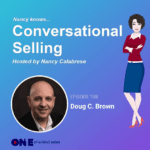Internalizing Cold Calling Scripts
 Cold calling is an opportunity to probe, build rapport and set the foundation for a long-term relationship. This involves improvising, asking probing questions and reacting to what the prospect is saying. That said, you still need to start with a script. While you don’t want to read it, you do want to use your script to prepare for the call.
Cold calling is an opportunity to probe, build rapport and set the foundation for a long-term relationship. This involves improvising, asking probing questions and reacting to what the prospect is saying. That said, you still need to start with a script. While you don’t want to read it, you do want to use your script to prepare for the call.
A well written script will:
- Remind you of what preparation needs to take place before the call begins
- Break down the call into steps so you know exactly where you are in the process at any time
- Provide ways to encourage conversation and get the prospect talking
- Help you avoid leaving out any questions or areas of information that you need to cover
- Give ways for probing the prospect to get to their pain points and other critical information and keep the process moving forward
- Provide reminders for critical pauses in the conversation
- Provide different call to action scenarios to maximize the outcome of the call
When cold calling, you absolutely want to be sure that you have a natural sounding conversation with your prospects. The only way to do this is by internalizing the script. Internalizing means incorporating within oneself as conscious or subconscious, the steps, questions and cues that you need to cover. This can be accomplished by knowing the script inside and out and making it part of you. The way to do this is by practicing.
What you don’t want to do is read a list of questions. Approaching the call in this way lacks the impression of genuine interest in what the prospect has to say, and your prospect will quickly lose interest in continuing the process. Reading the script will result in hang-ups, getting less information than you need, or the prospect will blow you off, either in a nice way or not.
Customize your scripts to address your particular circumstances and goals, and to address the information known about the prospect. This process of customizing and internalizing scripts is proven to be an effective approach in fulfilling your ultimate goal: setting sales appointments.

 In networking, a handshake is used to introduce yourself. It conveys a willingness to engage with someone that we don’t know or don’t know well. In the course of networking, we’ve all shaken a countless number of hands. Sometimes it leads to business relationships, but more often than not, it doesn’t.
In networking, a handshake is used to introduce yourself. It conveys a willingness to engage with someone that we don’t know or don’t know well. In the course of networking, we’ve all shaken a countless number of hands. Sometimes it leads to business relationships, but more often than not, it doesn’t. If you are looking for growth, (and who isn’t), it’s a good idea to pay more attention to Presales. Presales is key in obtaining, winning and keeping customers. You may not feel this way now but you’ll change your mind when you have a better understanding of what the Presales Process is and what it delivers.
If you are looking for growth, (and who isn’t), it’s a good idea to pay more attention to Presales. Presales is key in obtaining, winning and keeping customers. You may not feel this way now but you’ll change your mind when you have a better understanding of what the Presales Process is and what it delivers.

